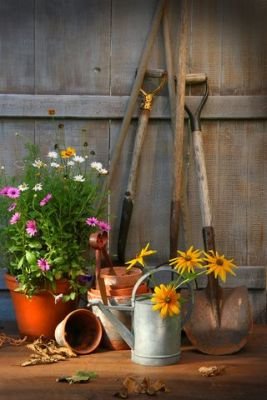Starting A Garden
Attracting Butterflies
|
|

|
Most areas in the United States wind prevails from the northwest.
|
|
These can be windbreak trees, a flowering hedge, privacy hedges and even a slope. |
Windbreaks can also be a house or different structures like a garden fence or fountain.
A garden windbreak will take the brunt of prevailing winds allowing:
- Smaller and less established vegetation have better chance of survival, especially in winter climates when starting a garden.
- Allow butterflies to be sheltered where they can feed. Butterflies will not stay around in a high wind area.
Rule of thumb:
- Tallest resilient plants or structure blocking north/northeastern parameter.
- Smaller flowers and less resilient plants on south/southeastern parameter.
Slopes breaking the north-westerly winds can be very inviting to develop a butterfly garden.
- A ready an willing windbreak.
- Flowers will be tilted making them more visible to a butterfly flying.
- Like most insects, butterflies are most active in the morning. The slope will get the morning and afternoon sunlight which is a necessity for butterflies.
If you live in a winter climate winds coming around the corners of a house, especially northwest winds can be relentless. While starting a garden in these area you need to protect newly planted vegetation. Black weed fabric will help these new plants survive by reducing exposure to the elements and even keep temperatures underneath warmer by a few degrees.
Black weed fabric is also used to suppress weeds, as the name implies. I place a lot of emphasis on weeds. As a beginner gardener I really liked some and not others. Understand how important they are to the butterfly is important and even more so, for the gardener to control.
Weeds - Think ahead and consider how they will be dealt with.
- Butterflies not only seek nectar from your flowers but weeds are also quite beneficial to them for nourishment and shelter.
- You may be tempted when starting a garden to transfer any pretty weeds to fill space. Apply caution and always remain in control of these garden weeds.
Weeds will especially be under control when understanding no space should be open and unoccupied. Exposed soil welcomes weeds.
The best butterfly gardens have both annuals and perennials.
You'll want both annuals and perennials when starting a garden for:
-
Nectar sources for butterflies.
- Annuals add more color attracting butterflies.
- Annuals will die off allowing you to give your next seasons garden to have a different look.
- As perennials become more established they require less work as seasons pass.
The second gardening season your plants will begin to develop and take shape if they are perennials. You may find that moving plants around will benefit other areas of your garden.
By the third year your garden will really look full and you will have developed an understanding for planting for the future. This also will help understand how your monies are spent.
Along the way you may discover soil areas where plants will not cultivate. Mulch can be placed over the area but another creative idea is to use these areas as water sources for butterflies along with areas for them to bask, or perch.
- Butterflies also need a water source. Create a puddle. If you place sand in a puddle it also provides necessary minerals while at the same time helps to keep other garden pests out.
- Have rocks placed strategically for butterfly basking. Place plastic underneath rocks so morning dew can roll down and collect at the bottom for water sources.
- Flowers and plants needs it, especially when starting a garden.
- Humidity is necessary for both caterpillars and butterflies.
Another thing when starting a garden is to consider the flowers, plants and butterflies that are local, or native, to your area.
Butterflies, flowers and plants are found all over the world. The butterfly species and plants native to a geographic area have evolved together for centuries and have adapted to local conditions.
State Butterfly - Understanding why attracting the local common butterflies to your butterfly garden is important. If you're not certain as to what butterflies are common to your area, learning if you have a state butterfly is a great place to start.
Exotic Butterfly - You will see other types of butterflies visiting your garden as it becomes more established, even as soon as the second year. You many be tempted to attract other butterflies to your garden that are not native to your area. Understand why this isn't a good idea is important.
good for you or your geographic environment, think about this
same term when it comes to plants. Inviting exotic flowers and plants could cause you headaches.
Butterfly Garden Plan - View their butterfly habitat as your butterfly sanctuary. Regardless of your space available with a butterfly garden plan there's a way to create a butterfly habitat that will work for both you and the butterflies.
Garden Tilling - This is top priority when starting a garden.
How to Attract Butterflies - Arrangement of plantings can be very important with attracting butterflies to your garden.
How do Plants Grow? - If one is a beginner gardener this is a brief tutorial of understanding plants, flowers and weeds and how they all grow.
Planting Zones - Different USDA maps including the hardiness zone map, rainfall map and frost map.
What is a Perennial Plant? - The two types of perennials and the common characteristics they have.
What are Annual Plants? - Similar characteristics as perennial flowers, but the big difference is in the name "annual". There are two types of annuals.
How to Water Plants - Summary of important considerations when watering plants. Also over/underwatering plants.
Pollination Process - Plants can also grow through the pollination process, which butterflies are a part of.
Growing Plants from Seed - This option is very inexpensive but can require practice. Sowing seeds can be done both indoors and out.
Buying Trees - Trees and plants come packaged differently. Understanding the pros and cons is good to know.
Transplanting Trees - Overall most gardeners don't have problems when transplanting trees. Problems can arise, some small others threatening a trees life.
Deer Prevention - Understanding the patterns of deer and the types of plants they tend to eat. Also see:
Attracting Deer - Plants that may be inviting them in!
Keeping Deer Out - An ongoing problem for many property owners.
Homemade Deer Repellent - Covers household and food items.
Butterfly House - Also known as butterfly boxes. Garden decorations that help promote butterflies to your space include butterfly boxes for hibernating. These have also been called hibernation boxes.
Raising Butterflies - This can be fun for you or with the kids. Raising butterflies falls under two categories - At Home and Commercial Purposes.
How to Raise Butterflies - Successfully raising butterflies at home.

Consider this gardening advice when planning a garden attracting butterflies...
Both butterflies and plants local to a region
require less attention. This is good news -
native vegetation doesn't require excessive
fertilizing and water. This means you save $$$!!!
Related Articles:
How to Kill Weeds - Understanding how to get rid of them.
Organic Mulch Types - Other weed suppressing options.
Back from Starting a Garden to Easy Butterfly Garden.com
 Copyright © 2010-2022 Easy-Butterfly-Garden.com
Copyright © 2010-2022 Easy-Butterfly-Garden.com
Privacy Policy Disclaimer

Join Easy Butterfly Garden on Facebook
Recent Articles
-
Annual Bluegrass
Jan 14, 17 08:14 PM
Annual bluegrass (Poa annua) is considered a weed in the Poa family, which has a few popular turf grasses. If this gets into your butterfly garden listed are a few ways to eradicate it.
-
Candytuft Flowers
Sep 25, 16 10:54 PM
There are the annual, or Iberis, candytuft flowers and also perennials which are called Iberis sempervirens.
-
Keeping Deer Out
Sep 19, 16 01:10 PM
Reviewing the types of products available for keeping deer out of our gardens along with building fences. Many of these products help with other garden pests.
-
Butterfly Meadows
Sep 19, 16 12:52 PM
Compared to other wildlife gardening, butterfly meadows take time and are not for the faint of heart.
-
Natural Gardening
Sep 19, 16 12:32 PM
Natural gardening includes different types of gardens. These garden types create a casual, natural envirionment and help sustain native wildlife which includes butterflies.






New! Comments
Have your say about what you just read! Leave me a comment in the box below.